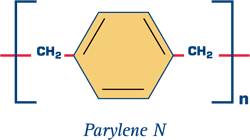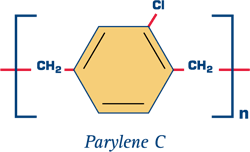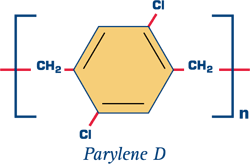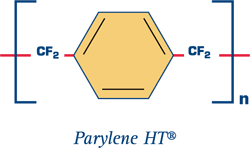パリレン特性
SCS パリレン特性
SCSパリレンコーティングの主な特性
SCSパリレンコンフォーマルコーティングは、超薄膜でピンホールがなく、優れた耐水性、耐薬品性、誘電バリア特性、熱安定性、紫外線安定性、ドライフィルム潤滑性を備えています。これらの特性によりパリレンコーティングは、医療機器、エレクトロニクス、自動車、防衛、航空宇宙産業における数多くの用途に最適です。
パリレンの種類とそれぞれ固有のメリット
パリレンの各種類はそれぞれ異なるメリットがあり、エンジニアリングの具体的なニーズに対応できます。以下は、市販されているパリレンの種類です:
パリレンN
パリレンNは完全な直線状の高結晶性材料であり、誘電正接が低く、高い絶縁耐力と、周波数に関わらず誘電率の変動が低いことで知られています。隙間への浸透性が非常に高いため、複雑な形状の用途に適しています。

パリレン C
パリレンCは、優れた電気的・物理的特性と、湿気や腐食性ガスに対する低透過性を併せ持つ、汎用性の高いタイプです。エレクトロニクスから防衛まで、幅広い用途に適しています。

パリレン D
パリレンCと似ていますが、熱安定性が強化されたパリレンDは、やや高い温度でも安定しているため、温度変化の大きい用途に理想的な保護膜となります。

パリレン HT
パリレンHT®は、高温環境に耐える必要がある部品の保護に優れています。このコーティングは、短時間であれば450℃までの温度に耐え、紫外線に対する長時間の耐久性に優れ、パリレンの中で最も低い摩擦係数と最も高い浸透性を特徴としています。

ParyFree®
ParyFree®は、パリレンCの高度なバリア機能を維持しながら、機械的・電気的コーティング特性を向上させた、ハロゲンフリーの製品です。世界的な環境基準への準拠が求められる産業向けに設計されています。
パリレンC-UVF®
パリレンC-UVF®は、コーティングの検証が重要な用途向けに、ブラックライトの下で蛍光を発する特殊な化合物を含んでおり、パリレンの本質的な特性を損なうことなく、コーティングの存在を確認することができます。
microRESIST®抗菌性パリレンテクノロジー
microRESIST®は、パリレンの生体適合性に抗菌性を組み合わせたことにより、コーティングされた医療機器の有害な微生物を効果的に排除します。この技術は、14種類の一般的な微生物に対して5Log 以上の減少を実証しており、信頼性の高い抗菌保護が可能です。
SCSパリレンの専門知識を活用する
これらのパリレンコーティングソリューションについての詳細情報や、それぞれの特性と利点については、SCSパリレン特性パンフレットに記載されています。パンフレットはSCSテクニカルライブラリでダウンロードできます。パリレンC-UVF®の市場別パンフレットと詳細もダウンロードできます。
パリレンの特性、試験方法、使用するメリットなどに関する具体的なお問い合わせは、オンラインでSCSまで、または +1.317.244.1200までお電話でご連絡ください。
